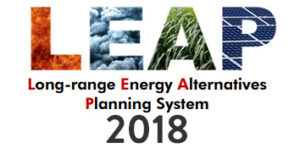The impacts of air pollution: SEI’s popular energy planning tool gets significant upgrade.

LEAP – a software tool for energy policy analysis and climate change mitigation assessment developed by SEI.
Policy-makers and researchers will be able to estimate how future emission reductions will impact health, crops and climate in a new version of SEI’s Long-range Energy Alternatives Planning (LEAP) system.
The newly released 2018 version includes numerous updates and additions to the widely-used energy analysis tool. This significant upgrade comes as the UN Environmental Assembly meets on Dec. 4 to discuss the need to confront pollution.
LEAP is user-friendly and free to developing countries, making it the de facto standard for integrated resource planning and greenhouse gas mitigation assessment. Now LEAP is expanding to cover land use and forestry, as well as emissions-related impacts.
Among the highlights is the Integrated Benefits Calculator (IBC), which translates emission scenarios into impacts, such as avoided premature deaths and crop losses. For example, policy-makers can see how many lives would be saved through an emissions reduction policy – and view that impact by age, disease and contributing pollutant.
LEAP-IBC can also estimate how future emission reductions would reduce the global temperature rise, putting regional action into a global perspective.
“These calculations can be run in just a few seconds and do not require the help of experienced modellers,” said Charlie Heaps, SEI senior scientist and LEAP developer. “For the first time, planners in developing countries can access – and easily use – this computing-intensive modelling methodology to estimate the impacts of air pollution, one of the top environmental killers.”
SEI developed LEAP-IBC in collaboration with the U.S. Environmental Protection Agency and Daven Henze at the University of Colorado, and with support from the Climate and Clean Air Coalition. It will be available to all of LEAP’s 35,000 users in 195 countries, including government agencies, academics, nonprofits, consultants and energy utilities.
Policy-makers can use LEAP-IBC not only to understand impacts but also to calculate future national emissions from greenhouse gases, short-lived climate pollutants (SLCPs) and other air pollutants.
The 2018 version of LEAP also comes with numerous other upgrades. They include capabilities to:
Jacques Peeters, a forest management expert who advises the Rwanda Water and Forestry Authority, said LEAP’s new land-use functions are crucial to the country’s revision of its Biomass Energy Strategy. LEAP, he said, can now estimate both sides of the biomass equation: supply and demand.
“The new features and tools integrated into LEAP have allowed us to provide different scenarios comparing supply and demand, providing a better overview of general tendencies for each scenario case,” Peeters said. “This will definitely help in designing the options for a new biomass strategy.”
For interviews and further information, please contact
Design and development by Soapbox.